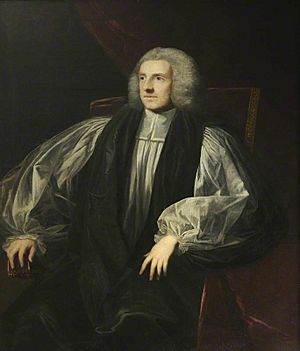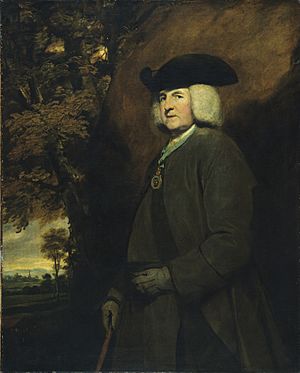Richard Robinson, 1st Baron Rokeby facts for kids
Quick facts for kids The Most Reverend and Right Honourable Richard Robinson D.D. |
|
|---|---|
| Lord Primate of All Ireland Lord Archbishop of Armagh |
|

Lord Rokeby by Sir Joshua Reynolds
|
|
| Church | Church of Ireland |
| See | Armagh |
| Appointed | 8 February 1765 |
| In Office | 1765-1794 |
| Predecessor | George Stone |
| Successor | William Newcome |
| Orders | |
| Consecration | 19 January 1752 by Charles Cobbe |
| Personal details | |
| Born | baptised 13 July 1708 |
| Died | 10 October 1794 (aged 86) Clifton, Bristol, England |
| Buried | St Patrick's Cathedral, Armagh |
| Nationality | English |
| Denomination | Anglican |
| Previous post | Bishop of Killala and Achonry (1751-1759) Bishop of Ferns and Leighlin (1759-1761) Bishop of Kildare (1761-1765) |
| Education | Westminster School |
| Alma mater | Christ Church, Oxford |

Richard Robinson, also known as the 1st Baron Rokeby (born in 1708, died October 10, 1794), was an important church leader. He was an Anglo-Irish man, meaning he had both English and Irish connections. He became the Archbishop of Armagh in Ireland, which was a very high position in the Church of Ireland.
Contents
Richard Robinson's Early Life and Education
Richard Robinson was born in 1708. His father was William Robinson, and his mother was Anne Walters. He had an older brother named Sir Thomas Robinson.
Richard went to Westminster School, a famous school in England. After that, he studied at Christ Church, Oxford University. He earned several degrees there, including a Bachelor of Arts (BA) in 1730 and a Doctor of Divinity (DD) in 1748.
Becoming a Church Leader in Ireland
In 1751, Richard Robinson moved to Ireland. He became a chaplain to Lionel Sackville, who was the Duke of Dorset and the Lord Lieutenant of Ireland. A chaplain is like a personal priest or minister.
Soon after arriving, Richard was made a bishop. His first role was as the Bishop of Killala and Achonry. He then became the Bishop of Kildare in 1761.
In 1765, he was given an even more important role. He became the Archbishop of Armagh. This made him the Primate of All Ireland, which is the highest church leader in the Church of Ireland.
Baron Rokeby: A New Title
In 1777, King George III gave Richard Robinson a special title. He was made Baron Rokeby. This meant he became a member of the Peerage of Ireland, a group of important noble families. The title was connected to Armagh, where he was the Archbishop.
When he died, his title passed to his second cousin, Matthew Robinson, who became the 2nd Baron Rokeby.
Richard Robinson's Contributions to Armagh
Archbishop Lord Rokeby was known for building and improving things in Armagh. He wanted to make the city a center for learning and health.
- 1774: He started the County Infirmary, which was a hospital for the area.
- 1771: He founded the Armagh Public Library, a place where people could read and learn.
- 1780: He gave land for a new prison to be built.
- 1790: He founded the Armagh Observatory. This was part of his bigger plan to create a university in Armagh.
Later Life and Legacy
Archbishop Lord Rokeby passed away in Bristol, England, on October 10, 1794. He was buried in Armagh Cathedral, where he had served for many years.
There is a special memorial inside Armagh Cathedral to remember him and his work.
What People Thought of Richard Robinson
Different people had different opinions about Richard Robinson.
- Robert Walpole, a famous politician, once said that Robinson was "a proud but superficial man."
- John Wesley, a well-known religious leader, thought that Robinson cared more about building grand structures than about helping people's spiritual lives.
However, Richard Cumberland, a writer, described him differently. He said Robinson was "splendid, liberal, lofty." He also said that Robinson was publicly ambitious to do great things and privately capable of good deeds. Cumberland believed that Robinson helped the whole nation through his public building projects.
Richard Robinson's Building Projects
Richard Robinson was a great supporter of architecture and building. He helped fund many important structures.
One example is the Canterbury Gate at Christ Church, Oxford University. This gate was finished in 1873. An inscription on the gate says it was built "By the munificence of alumni, especially of Richard Robinson, Archbishop of Armagh." This shows how much he contributed to his old university.
Images for kids




